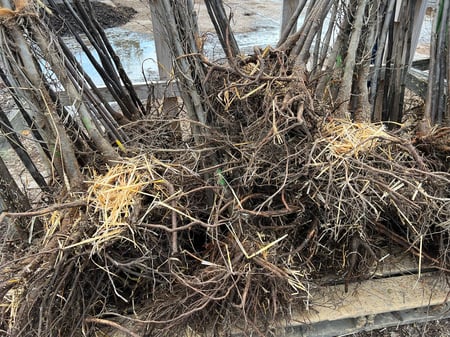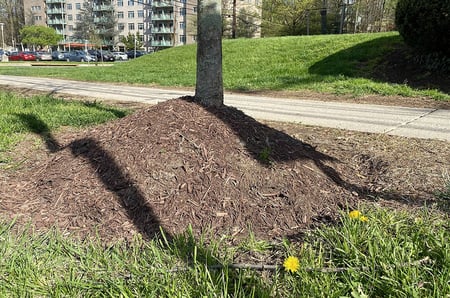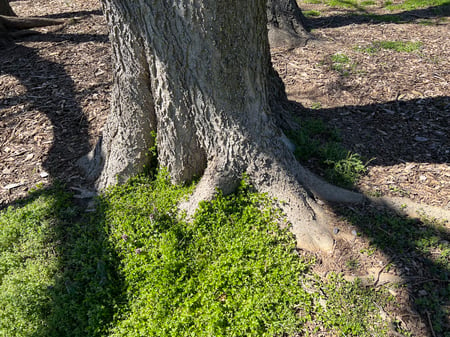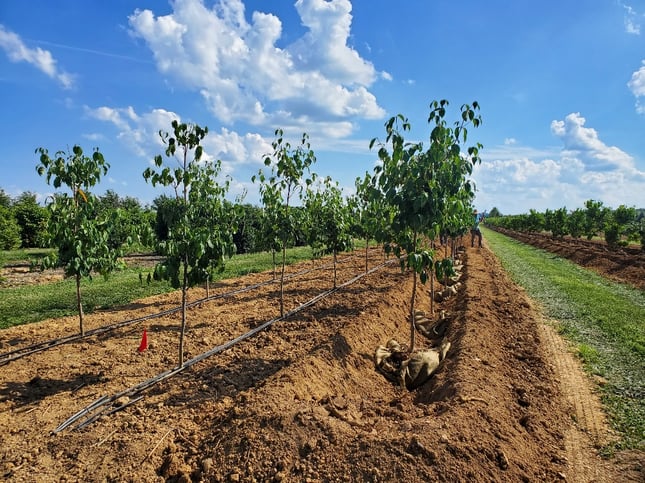Many things must go right to ensure that a rooted cutting or graft grows into a robust nursery tree or shrub in the field. Above all, planting depth at the nursery (and later when the tree is installed in a landscape) is critical because it determines whether the root flare will develop above ground where it belongs… or not.
For field grown trees and shrubs, correct planting depth alone will make or break our hopes for their long and happy future in the landscape.
Treat Nursery Trees Right - Don’t Bury the Root Flare
One of the most discouraging things we see in the landscape is a buried root flare; and we see it often. The root flare is part of the trunk, not the root system. Trunk bark is not water resistant and will decline if constantly covered.
Both field production nurseries and container growing operations are often blamed for buried flare. Even field operations of merit can have problems maintaining exposed root flare due to soil movement from wind and water erosion.
 We make it a standard policy at planting to get the depth perfect. That is easier said than done for a couple of reasons. We often plant trees that have no developed root flares to act as a guide. In such a case, we make the best estimate of where the root flare will develop.
We make it a standard policy at planting to get the depth perfect. That is easier said than done for a couple of reasons. We often plant trees that have no developed root flares to act as a guide. In such a case, we make the best estimate of where the root flare will develop.
The photo here shows grafted liners ready for transplant. The graft union is obvious. The root flare will develop where the grafted understock meets the soil line. Some tree liners are grown from seed (Styrax japonica, Acer griseum) or as a rooted cutting (Salix) none of which show the graft union. If such a liner is field grown by a liner grower, we can usually see the soil line and use that as a guide to planting depth.
In developing nursery trees for the wholesale market, a grower’s goal is to deliver a root ball with the root flare exposed. It’s not always going to happen. But if the initial field planting was close to the target, any discrepancy can be easily corrected at the time of transplanting.
Safeguarding Root Flare Is a Shared Responsibility
Responsibility for proper planting depth of nursery trees is shared between the grower and the landscaper. It is our responsibility to deliver a tree that has root flare sufficiently exposed and the landscape contractor’s to install it at the proper depth to maintain the flare.
For B&B trees, unwrap the burlap from the top of the root ball. If the root flare is not apparent, pull soil away from the trunk. Then position the root ball at a depth where the top is 1 ½ to 2 inches above the existing grade. Before backfilling, make sure the bottom of the hole contains native or compacted soil, so the ball does not settle over time. When you cover the root ball with mulch, do not allow mulch to touch the root flare and trunk.
Landscape Maintenance – Not Too Much Mulch!
 And speaking of mulch: Once a nursery tree has passed from the grower to the landscaper who installs it at the correct depth for root flare exposure, a landscape maintenance contractor takes over the long-term care. This is where we run into a related problem: too much mulch.
And speaking of mulch: Once a nursery tree has passed from the grower to the landscaper who installs it at the correct depth for root flare exposure, a landscape maintenance contractor takes over the long-term care. This is where we run into a related problem: too much mulch.
I can’t remember when I have seen a mulched tree with mulch not touching the tree trunk and root flare. This is sometimes referred to as a “mulch volcano”. You see evidence of this misguided practice all over, along parking strips and in municipal parks. And the effect of it grows worse over time as fresh mulch is piled on top of old season after season. Wet mulch piled against a tree trunk is an open invitation to rot, insect infestation, and disease.
When Trees Plant Themselves, They Do It Right
 In the forest, wild trees are able to achieve maturity with a mere six inches of soil on top of rock while sharing nutrients and water through the mycorrhizal web.
In the forest, wild trees are able to achieve maturity with a mere six inches of soil on top of rock while sharing nutrients and water through the mycorrhizal web.
When trees plant themselves, they do it right. When we do it, sometimes not. Planting a tree too deep or entombing it under a mountain of mulch is not something most trees can overcome themselves. They may live 15 to 20 years, but will likely die well before their time.
How do we get the word out about the need for restraint when mulching trees? I don’t know. I just know that we do our best to produce healthy plant stock. Once nursery trees leave our fields for residential landscapes near and far, their fate is in your hands. Treat them right, please.
We all stand to benefit from high value plant material sold at prices that honestly account for what it takes to produce that value. But how do we know we are purchasing the best plant material for the best price?
Our ebook “Why Accurate Plant Pricing is Good for Everyone” will give you a fresh perspective on the delicate balance between price and value.





